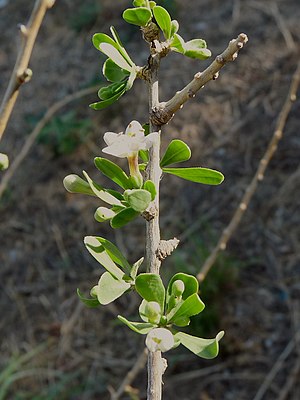Lycium europaeum
| Lycium europaeum | ||||||||||||
|---|---|---|---|---|---|---|---|---|---|---|---|---|

Lycium europaeum |
||||||||||||
| Systematics | ||||||||||||
|
||||||||||||
| Scientific name | ||||||||||||
| Lycium europaeum | ||||||||||||
| L. |
Lycium europaeum is a plant from the genus of Lycium ( Lycium ). This species is found mainly in the Mediterranean and Portugal.
description
Lycium europaeum is a shrub that reaches heights of 1 to 4 m. The stiff branches are covered with blunt thorns. The simple leaves are 20 to 50 mm long, 3 to 10 mm wide, and are usually inversely lanceolate.
The stalked, hermaphrodite flowers stand individually or in groups of two, less often three. The sepals are fused bell-shaped and 2 to 3 mm in size, with five calyx teeth or two calyx lobes. The pink or white colored corolla has a diameter of 11 to 13 mm, is narrowly funnel-shaped and forms 3 to 4 mm large corolla lobes. The stamens usually protrude from the crown, the stamens are hairless, more or less irregular.
The berry-shaped fruit is red and about 8 mm in diameter.
The number of chromosomes is 2n = 24.
ingredients
The plant is poisonous due to its content of alkaloids such as solasodine .
Occurrence
This species is mainly found in the Mediterranean and Portugal. According to evidence, it occurs in Albania , the Balearic Islands , France , Greece , Spain , Italy , Yugoslavia , Portugal , Sardinia and Sicily , as well as in Turkey , the occurrence in Corsica and Crete is not certain . The species is most likely introduced in many parts of the range.
Systematics
In some cases, a distinction is made between two varieties, but some sources also list them as individual species.
- Lycium europaeum var. Europaeum
- Lycium Europaeum var. Ramulosum (Dunal) Fiori
The latter differs from the first variety in that it has smaller leaves and larger flowers and a smaller habit, but is sometimes called Lycium intricatum Boiss. designated.
According to molecular biology studies, the species is most closely related to Lycium depressum . Both are classified in a large monophyletic clade of ancient species of the genus, but the exact relationships within the clade are still unclear.
use
Although the plant contains toxic alkaloids, there have been reports of food use. Then the fruits are eaten raw or cooked. The fruit contains many vitamins and minerals, especially vitamins A, C and E, flavonoids and other bioactive substances. Green parts of plants are prepared by boiling.
ecology
Lycium europaeum is one of the forage plants of the skull-and-neck caterpillars .
literature
- Thomas Gaskell Tutin et al .: Flora Europaea , Volume 3., Cambridge University Press, 1972, ISBN 0-521-08489-X
Individual evidence
- ^ Lycium europaeum at Tropicos.org. In: IPCN Chromosome Reports . Missouri Botanical Garden, St. Louis
- ↑ IPNI: Lycium intricatum , accessed September 9, 2007
- ↑ Flora Europaea: Lycium europaeum , online edition, accessed on September 8, 2007
- ^ Rachel A. Levin et al .: Evolutionary Relationships in Tribe Lycieae (Solanaceae) . In: DM Spooner, L. Bohs, J. Giovannoni, RG Olmstead and D. Shibata (eds.): Solanaceae VI: Genomics meets biodiversity. Proceedings of the Sixth International Solanaceae Conference , ISHS Acta Horticulturae 745, June 2007. pp. 225-239. ISBN 978-90-6605-427-1 .
- ↑ Sphingidae of the Western Palaearctic. AR Pittaway, accessed September 8, 2007 .
Web links
- Entry in Plants for a Future (English)
- Entry at GRIN
- JS Miller and RA Levin: Lycium europaeum . In: Project Lycieae